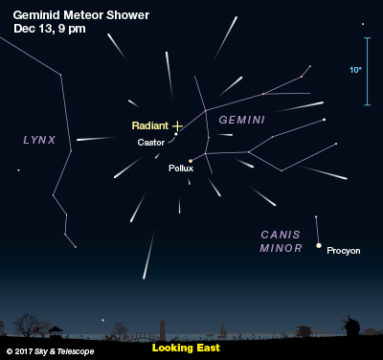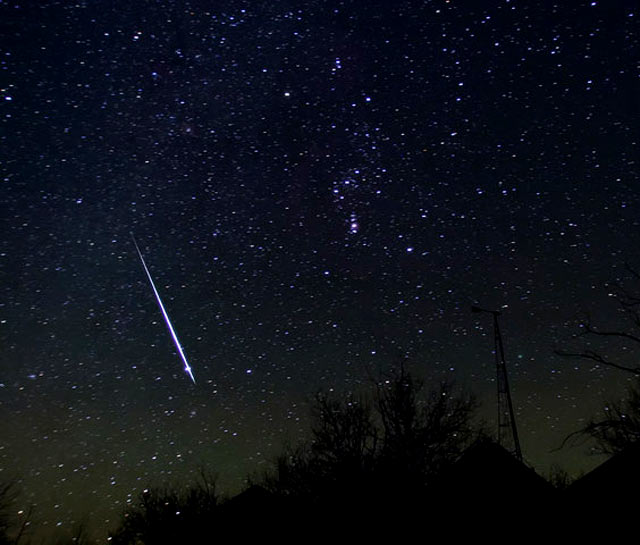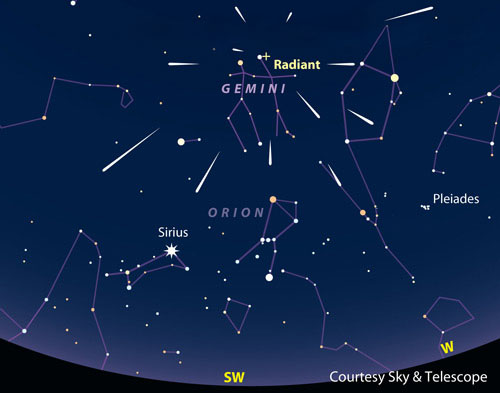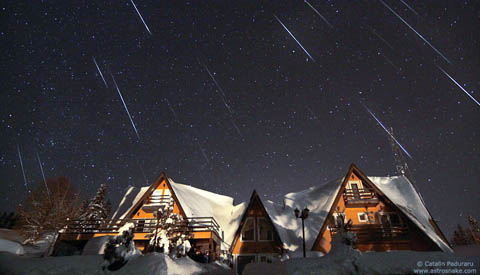Mark the date: December 13th. That's the night the Geminid meteor shower peaks. Highlighted by the return of its parent asteroid 3200 Phaethon, this year's show promises to be one of the best ever.

This is it, the shower we've been waiting for. Set aside some time Wednesday night December 13–14 for the Geminids. Not only is it the year's most prolific, with up to 120 meteors per hour visible from rural skies, the Moon is essentially out of the picture. Rising around 4:30 a.m. on the 14th, the waning crescent will shine just 3.5° north of the planet Jupiter in a frosting-on-the-cake conjunction to top off the big event.
The Geminid maximum also coincides with a bright return of its parent asteroid, 3200 Phaethon. On the night of maximum, Phaethon won't be very far away, clipping across neighboring Perseus at about 30″ a minute at its peak predicted magnitude of 10.7.
Set up the scope, spot papa, and then stretch out on the ground, suitably insulated from the cold with a blanket or sleeping bag, and witness his progeny put on a spectacular light show. For detailed maps of the asteroid's path, click here.
A word about that 120 per hour rate. That's the zenithal hourly rate, or ZHR, an idealized number based on observing under a pristine, moonless sky with the radiant at the zenith. Depending on the time you observe and local light pollution, counts will vary. At my observing site, which is handicapped by minor to moderate skyglow, I cut the rate in half to keep expectations realistic. A meteor a minute is certainly nothing to complain about.

Most major showers peak in the early morning hours. While that's also true of the Geminids, the shower offers something others don't: an evening matinee. You can spot a modest number of meteors visible starting as early as 9 p.m. because the radiant already stands some 30° high in the eastern sky. True, a fair number of shower members are cut off by the horizon at that time, but more of us are likely to go out and share it with our children in the evening as opposed to waking before dawn. Since Geminids travel at moderate to slow speeds and approach us from a low angle at that hour, they can produce brilliant and long-lasting fireballs.

If you want to experience the full power of the shower, set your clock for 2 a.m., when the radiant will be practically overhead. Shower members appear to originate or radiate from near Castor and Pollux in Gemini, the Twins. It may seem weird that the radiant is a point in sky until you realize you're staring down the shower's vanishing point, where the incoming meteoroids appear to converge in the distance, exactly the way railroad tracks appear to meet at the horizon.
As Earth plunges headlong into the debris left by the asteroid, each crumb leaves a hot streak of ionized air in its wake we see as a meteor. Though they may appear anywhere in the sky, every fragment flies in parallel, like a squadron of B-52s on a bombing run. Only a skosh faster — about 35 kilometers a second.
Convergence makes it easy to distinguish a Geminid from a random or sporadic meteor. If you can trace the bright streak back to the Twins, you can confidently say you've witnessed a millimeter fragment of an asteroid burn up in the atmosphere. Farewell, spawn of Phaethon.
After getting washed out by last year's supermoon, we look forward with anticipation to a truly excellent show this year. Although northern hemisphere skywatchers are favored, the Geminids are also visible with reduced numbers from Down Under, where the radiant stands some 40° high from northern Australia around 2 a.m. local time. With near-peak numbers lasting about a day, the entire planet except for Antarctica, where the Sun now shines 24/7, will get a crack at the shower.

Catalin Padraru
To summarize: If you're meteor-watching in the evening, head out around 9 p.m. local time or later and observe from a place as far from city lights as possible. Bring warm clothing and a blanket or sleeping bag for huddling and cuddling and face east. Then, just lie back and wait for the meteors to flare. Even 30 minutes of watching should net a few celestial sparks. If you want to catch the peak, plan on watching from about 1–3 a.m. facing south on Thursday morning the 14th. Even 3–5 a.m. works if you're keen on that conjunction.
Prospects for this year's Geminids are so good, only cloudy skies could muck it up. But that won't happen, right? If bad weather prevails, you can still watch the shower at Gianluca Masi's Virtual Telescope Project site live from Italy starting at 22:00 UT (5 p.m. EST) Dec. 13 and from Arizona at 10:00 UT (5 a.m. EST) on the 14th.
 17
17









Comments
Tom-Reiland
December 6, 2017 at 2:27 pm
Bob, Thanks for guaranteeing cloudy weather for Western Pa next week. Our weather in December is usually poor, but this makes it almost a certainty that we won't see the night sky all of next week. Hope you have better luck. As a friend of my says, it's always clear ten miles from us, straight above us.
You must be logged in to post a comment.
Bob KingPost Author
December 6, 2017 at 10:27 pm
Tom,
Happy to help 🙂 No, seriously, I hope you're in for a pleasant surprise.
You must be logged in to post a comment.
federico13
December 12, 2017 at 12:18 pm
un grazie infinite ad esplorar lo cielo intento
You must be logged in to post a comment.
Tom Hoffelder
December 11, 2017 at 11:54 am
Hoffelder's corollary (to Murphy's Law), rev 2: The probability of cloud cover at night is a) inversely proportional to the amount of moonlight in the sky, and b) directly proportional to the observer's level of interest in any celestial event, with the latter taking precedence when applicable.
You must be logged in to post a comment.
aneedham
December 8, 2017 at 8:23 pm
For those of us outside the US, could you give the Universal Time(s) and date at which peak activity is expected?
Thanks.
You must be logged in to post a comment.
Bob KingPost Author
December 8, 2017 at 11:34 pm
Aneedham,
Of course! Peak occurs around 6h UT on Dec. 14.
You must be logged in to post a comment.
December 8, 2017 at 11:13 pm
Great article, Bob! Forwarding to attendees at Geminids Watch at Howard County Conservancy here in MD. Always our best, as well as coldest, meteors watch of the year.
You must be logged in to post a comment.
Bob KingPost Author
December 8, 2017 at 11:35 pm
Thanks, Stardoc. Good luck and clear skies!
You must be logged in to post a comment.
bclose
December 10, 2017 at 10:08 am
How long of a period does this shower left? I won’t be able to get out until Friday night am I out of luck?
You must be logged in to post a comment.
Bob KingPost Author
December 10, 2017 at 10:56 am
Hi bclose,
The maximum and good activity is spread over about two days but drops off quickly after that. Since you'll watching one day after the maximum, you'll still see some Geminids.
You must be logged in to post a comment.
David Oesper
December 11, 2017 at 1:40 am
Wouldn't it be great if we had a Meteor Watcher's Network so meteor enthusiasts escaping cloud cover could find suitable places to observe on short notice?
http://cosmicreflections.skythisweek.info/2017/12/11/meteor-watchers-network/
You must be logged in to post a comment.
Tom Hoffelder
December 11, 2017 at 12:05 pm
So nice to see words about ZHR! Most mainstream media articles simply say "expect to see as many as 120/hr," disregarding the fact that that is the ZHR number, and the fact that it makes a difference when you look. I saw some articles for the Leonids last month saying look as soon as it gets dark, totally ignoring the fact that the radiant doesn't rise until at least 11 PM. As far as what could go wrong, see my corollary reply to Mr. Reiland above. Perhaps you know that he and I were the first observers, as far as we know, to see more than 100 M objects in one night.
You must be logged in to post a comment.
Anthony Barreiro
December 14, 2017 at 5:16 pm
ZHR also assumes a limiting naked-eye magnitude of 6.5. If you're in a city with a limiting magnitude of 3 or 4, you won't see any of the faint meteors.
You must be logged in to post a comment.
Anthony Barreiro
December 14, 2017 at 5:21 pm
It's been fairly clear here in SF (good for skywatching, not so good for taking showers next year!). I saw a few Geminids from my light-polluted back yard, including a couple of really bright ones, magnitude -1 or -2 -- one about 0500 PST yesterday morning 13 December, and one about 2200 PST last night, 13 December. I am grateful to all my immediate neighbors for getting into the habit of turning off their outside lights when they're not using them.
You must be logged in to post a comment.
Graham-Wolf
December 14, 2017 at 8:34 pm
Hi Bob
Call it the "dastardly Digit of Destiny" or the "Fickle Finger of Fate", but I was murphied out by overcast skies BOTH nights. Might have to call this effect the "Occultids"!
Did manage to briefly sight Paethon a few days ago, near it's peak. Rather faint in my 12cm f8.3 Newtonian.
Graham W. Wolf at 46 South, Dunedin, NZ.
You must be logged in to post a comment.
Farley
December 16, 2017 at 6:30 pm
Hi Bob
Somewhat disappointed by the observations from my location - Sierra foothills east of Sacramento at 1700'. Very clear and little light pollution. Went out 3 times for about 10 min. each - 9:00 PM PST, 10:00 PM and 11:00 PM. Saw maybe about 15 with only two of those being really good ones. Your thoughts?
You must be logged in to post a comment.
Bob KingPost Author
December 16, 2017 at 9:53 pm
Farley,
Here's the ZHR results from the International Meteor Organization: https://www.imo.net/members/imo_live_shower?shower=GEM&year=2017
The peak was late on the 13th PST. When were you out? It's possible you hit some gaps when few meteors appeared. During my vigil late on the 13th (Central time), there were occasional periods lasting ~5 minutes when I didn't see a single meteor, then there'd be a burst of four or one a minute followed by another gap.
You must be logged in to post a comment.
You must be logged in to post a comment.